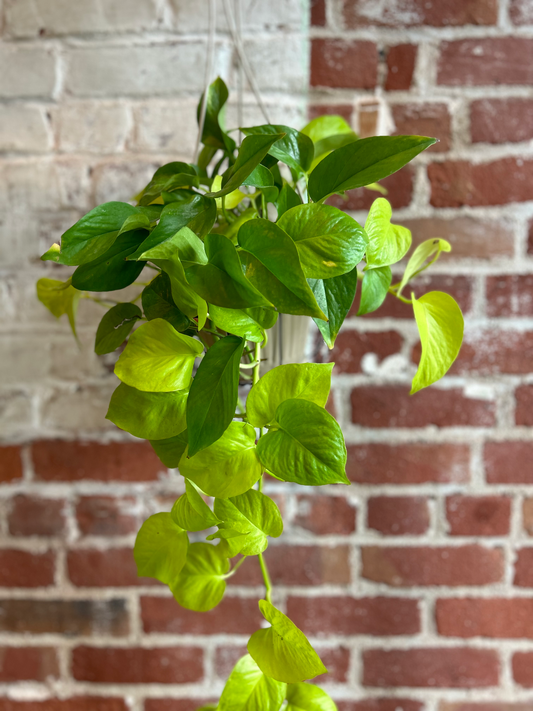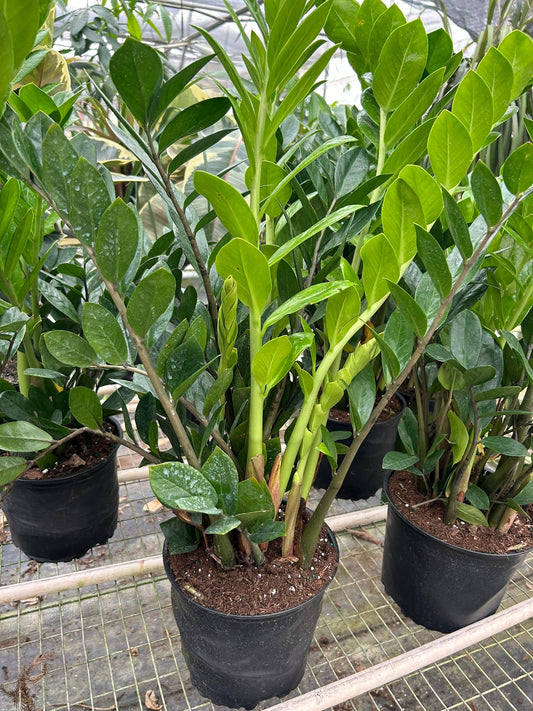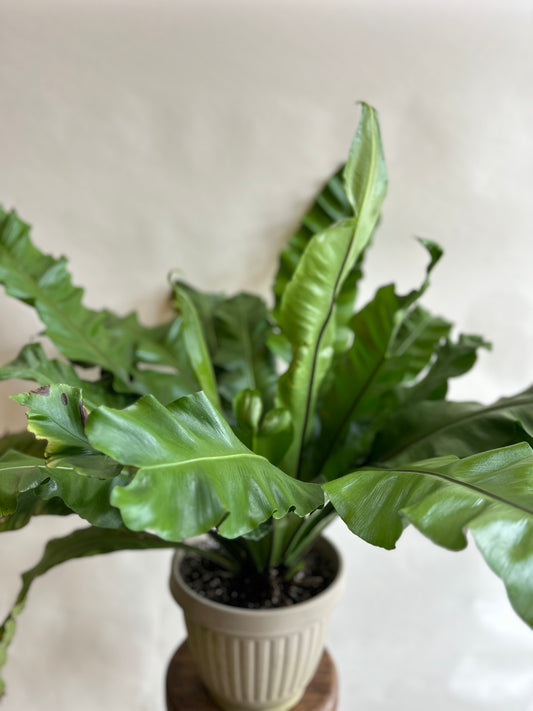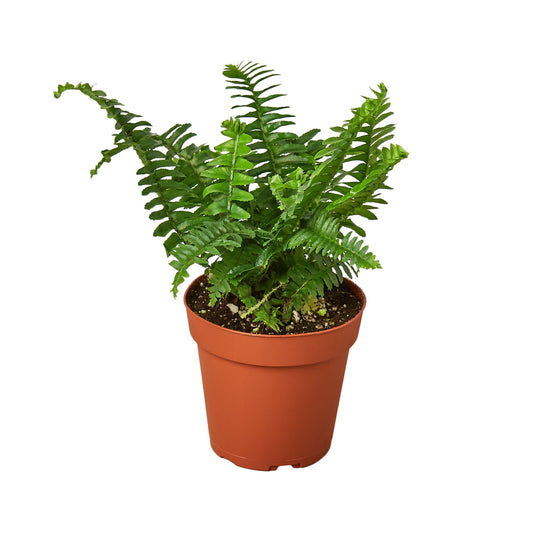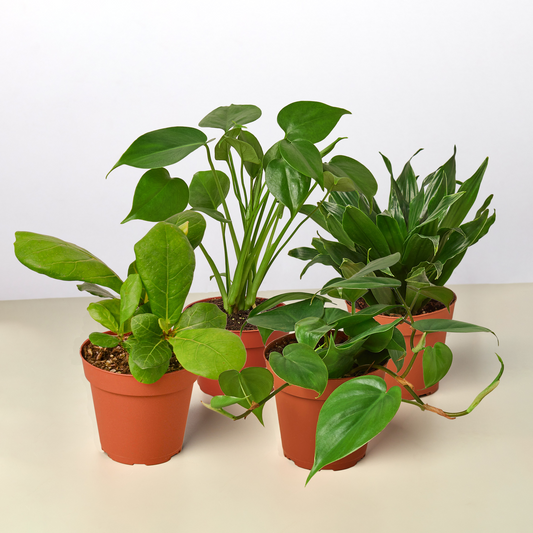How to Grow and Care for Pink Anthuriums
Cafe Planta Team
Have you ever laid eyes on the mesmerizing pink anthurium? With its glossy leaves and vibrant pink spathes, it's a plant that can transform any corner of your home into a visual delight. If you're intrigued by its charm and thinking of adding it to your indoor garden, you're in for a treat.
In this article, we'll go on a journey through the essentials of growing and caring for pink anthuriums. We'll cover everything from selecting the right pot and soil to creating an ideal environment and troubleshooting common issues. Whether you're a seasoned plant parent or just starting out, you'll find practical tips and advice to help your pink anthurium thrive.
Choosing the Right Pink Anthurium
The first step in cultivating a beautiful pink anthurium is selecting the right plant. When you're at a plant shop, you want to look for a healthy specimen with vibrant foliage and strong stems. Avoid plants with yellowing leaves or brown spots, as these might indicate underlying health issues.
There are several varieties of pink anthuriums, each with its own unique shade of pink. Some popular choices include:
- Anthurium 'Pink Lady': Known for its bright pink spathes and shiny green leaves.
- Anthurium andraeanum 'Pink Champion': Offers a deeper pink color, almost bordering on red, with a more dramatic flair.
- Anthurium 'Sweet Dream': Features a softer, pastel pink that adds a delicate touch to any space.
Once you've chosen your pink anthurium, it's time to bring it home and find the perfect spot for it to settle in.
Creating the Perfect Environment
Pink anthuriums hail from tropical climates, so they thrive in conditions that mimic their natural habitat. That means warmth and humidity are your best friends. Here are some tips to create a cozy environment for your new plant:
- Temperature: Aim to keep your anthurium in a spot where temperatures range between 65°F and 80°F. They don't appreciate drafts or sudden temperature changes, so keep them away from vents and open windows.
- Humidity: These plants love moisture, so consider using a humidifier or placing a tray of water near the plant to increase humidity levels. Grouping plants together can also help raise the humidity.
- Light: Pink anthuriums prefer bright, indirect light. Too much direct sunlight can scorch the leaves, while too little light can hinder growth and blooming. A north or east-facing window is often ideal.
Remember, consistency is key. Try to maintain a stable environment to keep your anthurium happy and healthy.
Potting and Soil Tips
The right pot and soil can make all the difference for your pink anthurium. When choosing a pot, go for something with adequate drainage holes. Anthuriums don't like to sit in water, so good drainage is essential to prevent root rot.
As for soil, you'll want a mix that retains moisture but also allows for airflow. Here's a simple potting mix recipe you can try:
- 1 part orchid bark: Provides structure and aeration.
- 1 part peat moss or coco coir: Retains moisture without becoming waterlogged.
- 1 part perlite or pumice: Enhances drainage and keeps the soil light.
When potting your anthurium, make sure to gently loosen any compacted roots and position the plant at the same depth it was growing in its previous container. Fill in with your potting mix, lightly pressing down to secure the plant in place.
Watering Your Pink Anthurium
Getting the watering routine just right can be a bit tricky but is crucial for the health of your pink anthurium. Generally, these plants prefer their soil to dry out slightly between waterings. Overwatering is a common pitfall, leading to root rot.
Here's a simple strategy to follow:
- Check the soil: Before watering, stick your finger about an inch into the soil. If it feels dry, it's time for a drink. If it's still moist, wait a few more days.
- Water thoroughly: When you do water, make sure to soak the soil completely. Allow the excess water to drain out of the pot.
- Adjust for the seasons: During the growing season (spring and summer), your anthurium might need more frequent watering. In the cooler months, water less often.
Remember, each home is unique, so you might need to tweak this routine based on your specific environment.
Feeding and Fertilizing
While pink anthuriums aren't particularly heavy feeders, they do appreciate a little nutritional boost now and then. Feeding your plant during its active growing months can encourage lush foliage and more blooms.
Here's how to fertilize your anthurium:
- Choose the right fertilizer: Opt for a balanced liquid fertilizer diluted to half strength. A 20-20-20 formulation works well.
- Frequency: Feed your anthurium every 6-8 weeks during the spring and summer. Reduce or stop feeding in the fall and winter when growth naturally slows down.
- Avoid over-fertilizing: Too much fertilizer can lead to salt build-up in the soil, which can damage the plant. Always follow the instructions on the fertilizer package.
With a little bit of attention to feeding, your pink anthurium will reward you with vibrant growth and stunning pink spathes.
Pruning and Maintenance
Pruning your pink anthurium isn't just about keeping it tidy; it's also an essential part of plant care that can encourage new growth. Here's how to go about it:
- Remove yellow or brown leaves: Use clean, sharp scissors or pruners to snip off any dead or damaged foliage at the base. This helps the plant focus its energy on healthy growth.
- Cut back leggy stems: If your anthurium starts to look a bit leggy, you can trim back some of the longer stems to promote a bushier appearance.
- Clean the leaves: Dust can accumulate on the glossy leaves, so wipe them down with a damp cloth every few weeks to keep them looking their best.
Regular maintenance not only keeps your plant looking beautiful but also helps it stay healthy and strong.
Common Problems and Solutions
Even with the best care, your pink anthurium might encounter a few bumps along the way. Here are some common issues and how to tackle them:
Yellowing Leaves
Yellow leaves can result from overwatering, insufficient light, or nutrient deficiencies. Check your watering routine and ensure your plant is getting enough indirect sunlight. If necessary, consider feeding with a balanced fertilizer.
Brown Leaf Tips
This is often a sign of low humidity or too much fertilizer. Increase the humidity around your plant, and make sure you're not over-fertilizing. Adjust your care routine as needed.
Pests
Anthuriums can occasionally attract pests like aphids or spider mites. If you notice tiny bugs or webbing, treat your plant with insecticidal soap or neem oil. Regularly inspect your plant for signs of pests to catch them early.
Addressing these issues promptly can help keep your pink anthurium thriving.
Incorporating Pink Anthuriums into Your Home Decor
Beyond their botanical allure, pink anthuriums are also design darlings. They can be a bold statement piece or a charming addition to any room's decor. Here are some ideas for styling your pink anthurium:
- Table Centerpiece: Place your anthurium in a decorative pot and use it as a centerpiece on your dining or coffee table. Its vibrant pink blooms will draw attention and add a splash of color.
- Bathroom Oasis: Since anthuriums love humidity, they can thrive in a well-lit bathroom. Add some other tropical plants to create a mini jungle vibe.
- Bedroom Accent: Set your anthurium on a nightstand or dresser for a touch of tranquility and beauty. The pop of pink can brighten your mornings and soothe your evenings.
Regardless of where you place it, a pink anthurium can enhance the aesthetic of any space with its stunning beauty.
Propagating Your Pink Anthurium
If you've fallen in love with your pink anthurium and want to expand your collection, propagation is a rewarding project to try. The most common method is division:
- Timing: The best time to propagate is during the spring or early summer when the plant is actively growing.
- Preparation: Carefully remove your anthurium from its pot and gently separate the root ball into smaller sections. Each section should have a few leaves and a healthy root system.
- Planting: Pot each division into its own container with fresh potting mix. Water thoroughly and place in a warm, bright spot.
With patience and care, you'll soon have several pink anthuriums to enjoy or share with friends.
Final Thoughts
Pink anthuriums are a delightful addition to any plant collection, and with the right care, they can bring vibrant beauty to your home. From selecting the perfect plant and creating a tropical environment to troubleshooting common issues, you've got all the tools you need to succeed.
At Cafe Planta, we're passionate about helping you nurture your plant journey. Whether you're looking for new additions or need advice, we're here for you. Feel free to email us or reach out on Instagram. Let's grow together and create a green sanctuary in your home.


